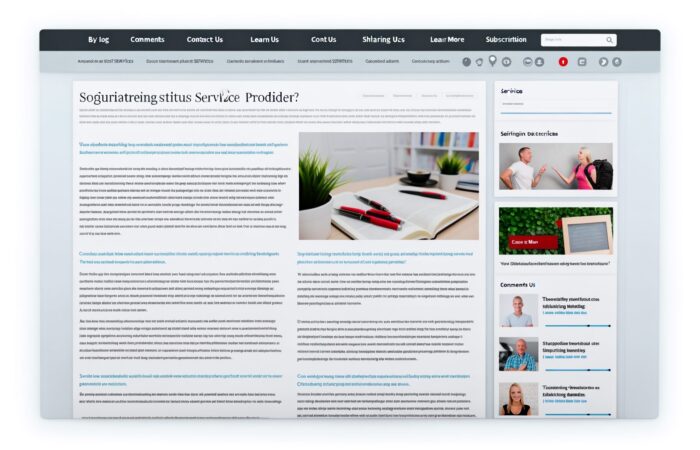Introduction to Strategic Collaborations
Hey there! Ever wondered how some businesses manage to keep shooting skywards, while others struggle even to keep their heads above water? Well, one of the secrets to their success could very well be strategic collaborations. So, let’s dive into what this buzzword means and how it can turn into a game-changing strategy for business growth and visibility. Trust me, it’s more exciting than it sounds!
First off, let’s clear up what strategic collaboration actually means. In the simplest terms, it’s about forming partnerships where each party brings something unique to the table—be it resources, expertise, or market access—which they then leverage to achieve mutual goals that seemed a bit daunting to tackle solo. Think of it as a superhero team-up where everyone’s strengths are maximized, and weaknesses minimized!
But Why Collaborate?
You might be thinking, “I’m doing fine on my own, why bring someone else into the mix?” Great question! Here are a few reasons:
- Variety of Perspectives: Working with someone from a different background or industry can provide fresh insights that you might not have considered.
- Shared Resources: Whether it’s splitting costs, sharing networks, or pooling together technology and tools, collaboration can lead to significant savings and enhanced capabilities.
- Faster Growth: By combining forces, you can speed up the process of achieving your goals, be it entering new markets, enhancing your product line, or reaching more customers.
What Makes a Collaboration Strategic?
Now that we’re on board with why to collaborate, let’s talk about making it strategic. Here’s the key: a strategic collaboration isn’t just any partnership; it’s a well-planned alliance aimed at achieving specific business objectives. This requires thoughtful selection of partners, clear communication of goals, and an understanding of what each party stands to gain—and lose.
So, think about collaborations like building a bridge. You need a good reason to build it, a clear understanding of who it’s for, and a solid plan to construct it sturdily. Otherwise, it won’t stand the test of time, let alone bring any real benefits.
Wrapping Up
Embarking on a journey of strategic collaboration can seem overwhelming initially, especially when trying to find the perfect partners and setting up terms that provide clear wins for everyone involved. But with the right approach, strategic collaborations can open up avenues of opportunities that weren’t accessible before.
So, as we wrap up this section, remember: collaborations are not just about sharing burdens; they’re about multiplying successes. When done right, they can lead to breakthrough innovations and solutions that make a real difference. Stick around, and let’s explore how to identify those potential partners in our next section!
Identifying Potential Partners for Collaboration
When we start thinking about collaboration, the first hurdle often feels like a big one: Who do we team up with? It’s like standing at a party wondering who to talk to, isn’t it? But identifying the right partners for collaboration doesn’t have to be daunting. Here’s a fun and friendly guide to making those all-important connections.
First things first, let’s think about your goals. What are you hoping to achieve with this collaboration? Are you looking to expand your audience, increase brand awareness, or maybe enter new markets? This will dictate the kind of partner you’re looking for. For instance, if you’re aiming to tap into a younger demographic, you might look for partners who are already smashing it in that space.
Narrowing Down the Right Fit
Now, let’s get down to brass tacks and figure out who these potential partners might be. Here’s a little checklist to help streamline your search:
- Aligning Values: Ensure your potential partner shares similar values and ethics. This alignment can drive the collaboration smoothly towards mutual goals.
- Complementary Strengths: Look for partners who bring something different to the table. If you’re a tech whiz, maybe partner with a creative powerhouse. The contrast can lead to incredible results!
- Audience Overlap: It’s beneficial if you share a similar target audience but not so overlapping that you’re competitors. Think of it as sharing a slice of cake without eating into each other’s piece.
Effective Scouting Techniques
With your checklist ready, how do you actually find these unicorns? Well, it’s not just about looking out; it’s also about making yourself visible and approachable:
- Networking Events: Yes, good old face-to-face networking still works wonders. Attend industry meetups, seminars, and workshops. You never know who you might bump into.
- Social Media: Utilize LinkedIn or Twitter to connect with thought leaders and influencers in your niche. Engaging with their content can get you noticed.
- Referrals: Sometimes the best connections come from within your existing network. Let colleagues, clients, and friends know you’re looking for a collaboration. Word of mouth is powerful!
And remember, the approach doesn’t have to be overly formal. A simple, friendly message that says, “Hey, I love what you are doing with [specific project or product]. I think there’s a great opportunity for us to collaborate and create something exciting together!” can work wonders.
Once you start discussions, keep an open mind. Effective collaboration is not just about enhancing your visibility; it’s a learning curve and a chance to create something uniquely beneficial for both parties. Be prepared to listen as much as you talk, and stay open to new ideas.
By identifying the right partners and reaching out in the right ways, you set the stage for a collaboration that could expand your horizons more than you ever imagined. So don’t be shy—get out there and start connecting!
Leveraging Social Media Platforms for Enhanced Visibility
When dipping your toes into the vibrant pool of strategic collaborations, it’s hard to overlook the power of social media. It’s no longer just about posting what you had for lunch or the occasional vacation snap—it’s a goldmine for boosting your collaborative projects to new heights. Let’s dive into how you can use these platforms to not only shine a spotlight on your collaborations but also engage and grow your audience in meaningful ways.
The Art of Choosing the Right Platforms
Not all social media platforms are created equal, especially when it comes to the nature of your collaboration. Choosing the right platform can be akin to selecting the perfect spice for a dish—it can enhance the flavor beautifully or overshadow it completely. For instance, if your collaboration involves visually compelling content, platforms like Instagram and Pinterest might be your best bet. On the other hand, if it’s more about thought leadership and professional insights, you might find a more engaged audience on LinkedIn.
Everyone loves a good teaser, right? Sharing snippets or behind-the-scenes looks at your upcoming collaborative projects can create anticipation and buzz. This approach not only keeps your audience’s attention but also builds excitement towards the big reveal. Think of it as the trailer to your blockbuster movie! Whether it’s a sneak peek of a new product, snippets from a collaborative blog post, or previews of a joint webinar, these glimpses can help stir curiosity and engagement.
Engaging with Your Audience
Engagement is the soul of social media. It’s not enough to just post content and hope for the best. Encourage interaction by posing questions, running polls, or even hosting live Q&A sessions with your collaborators. This not only makes your audience feel valued but also helps in fostering a community that is actively involved in the narrative you and your partners are creating. Plus, every comment, share, and like increases your project’s visibility, naturally boosting its reach through the algorithms that govern our feeds.
Think of hashtags as the signposts that guide users to your content. Creating unique, memorable hashtags for your collaboration can help unify your posts across different platforms and make them easy to find. Moreover, encourage your partners and audience to use these hashtags when talking about the project. This not only increases visibility but also allows you to track engagement and gather feedback directly from your community.
Amplifying Through Partners’ Networks
This is where the magic of collaboration multiplies your efforts. When each partner shares content through their individual networks, it amplifies your reach exponentially. Imagine your visibility not as a single spotlight but as a network of interconnected beams, each adding more light and covering wider ground.
In conclusion, social media is not just a tool for sharing; it’s a dynamic platform that, when wielded correctly, can significantly enhance the visibility of your collaborations. From choosing the right platforms to engaging actively with your audience, each step you take can be strategically used to not only spotlight your project but also to build an enduring relationship with your audience. So, get creative, stay authentic, and watch as your collaborative efforts flourish across the digital landscape!
The Role of Content Marketing in Collaborative Strategies
So, we’ve talked about identifying potential partners and leveraging social media, but how does content marketing fit into the puzzle of strategic collaboration? Well, let me tell you, it’s a hefty piece that can really help amplify your efforts and outcomes!
Building a Content Bridge
Imagine two islands. One is you with your unique services or products, and the other is a partner with their own set of offerings and audience. Content marketing in this scenario acts like a robust bridge connecting these islands. By co-creating content, you not only share resources but also tap into each other’s audiences. It’s a win-win!
Types of Content to Co-create
- Blog Posts: Pool your expertise to produce insightful articles that resonate with both your audiences.
- Videos: They say a picture is worth a thousand words, well, a video must be worth a million then! Collaborative videos, interviews, or even webinars can drive significant engagement.
- Infographics: Combine your data to create compelling visual content that is easy to understand and share.
Each type of content lets you tell a story together that could be more powerful than what you could do alone. Now, isn’t that something?
Sharing Is Caring!
Sharing each other’s content can dramatically widen your reach. When you share your collaborative content, you’re essentially introducing your audience to your partner and vice versa. This strategy allows both parties to benefit from each other’s network, multiplying your visibility and impact significantly.
SEO Benefits
When you collaborate on content, especially online content like blogs or whitepapers, you’re also enhancing your Search Engine Optimization (SEO) efforts. How? Through shared links and combined keyword strategies that drive up your search rankings. Better visibility in search engines means more organic traffic – not just for you but for your partner too!
Furthermore, this type of content collaboration enhances credibility. By associating with other respected entities in your industry, you are building trust with your audience. They see that other credible businesses align with your brand, bolstering their confidence in you.
Keep the Momentum Going
One-off collaborations are great, but the real magic happens when these engagements are continuous. Consider establishing a regular cadence for collaborative content. Maybe it’s a monthly guest blog swap or a quarterly webinar series. Consistency keeps your audience engaged and looking forward to more, always wondering, “What will they come up with next?”
Content marketing, in the realm of strategic partnerships, is not just about pushing boundaries with what you can create but also about building long-lasting relationships that foster a genuine spirit of cooperation. It’s about combined strength working towards a unified goal. Isn’t it thrilling to think about the endless possibilities when minds and creativity converge?
So, let’s not shy away from embracing the power of joining forces. After all, when we pool our talents, the results can be truly spectacular. Ready to bridge the gap with content marketing?
Events and Webinars as Tools for Strategic Collaboration
Now, let’s dive into one of the most dynamic facets of strategic collaboration—events and webinars. These are not just gatherings; they are powerful platforms to boost engagement, share knowledge, and strengthen partnerships in a real-time environment. Picture this: your organization teams up with a complementary partner to host a webinar on a hot topic in your industry. The result? A win-win situation where both parties leverage each other’s audience and expertise, expanding their reach and impact.
First off, why choose events and webinars? Because they bring a personal touch to the digital world. They foster a sense of community and immediacy that other digital strategies might lack. It’s about creating an interactive space where real connections are made. Think of it as hosting a vibrant dinner party, only with insightful discussions that could spark the next big idea in your industry!
Planning Your Collaborative Event or Webinar
- Define your objectives: Are you aiming to educate, generate leads, or perhaps showcase a new product with your collaborator? Clarity on goals guides the format and content of your event.
- Choose the right partner: This should be someone whose business values and customer base complement yours. This alignment is crucial for delivering cohesive and impactful messages.
- Decide on a format: Panel discussion, interactive workshop, or a Q&A session? Your format should cater to the interests and preferences of your combined audiences.
- Promote effectively: Utilize both partners’ social media channels, email lists, and other marketing resources to drum up excitement and attendance.
Making the Most Out of the Event
During the event, engagement is key. Encourage live tweeting, sharing, and participation. Use polls, surveys, and Q&A sessions to make the experience interactive and lively. Here’s where the magic of collaboration really comes into play—you get to mix and match your strengths to create an engaging and enriching experience for attendees.
Post-event follow-up is equally vital. Send thank-you emails, share recordings of the event, and perhaps a collaborative content piece, like a whitepaper or a series of blog posts highlighting key takeaways. This not only extends the life of your event but also keeps your audience engaged long after it’s over.
Reaping the Benefits
So, what are the real benefits of using events and webinars for strategic collaboration? Here’s the scoop:
- Enhanced visibility: By pooling resources and audiences, you significantly broaden your reach.
- Authority building: Collaborating with other industry players can position you as a thought leader.
- Lead generation: Events and webinars provide a prime opportunity to capture highly engaged prospects.
- Networking: They create platforms for networking not just for the hosts but also for attendees, fostering new business opportunities and partnerships.
Incorporating events and webinars into your strategic collaboration toolkit can transform how you engage with both your current audience and potential customers. It’s about creating memorable experiences that resonate and build lasting relationships. Dive in, the potential is immense!
Analyzing the Impact of Collaborative Efforts on Visibility
So, we’ve talked about how to join forces with other brands and influencers to boost your visibility, right? Now, let’s dive into something super crucial – analyzing the impact of these strategic collaborations. It’s like checking the scoreboard after a big game; you want to know if your team-up was a hit or a miss!
First things first, understanding the impact of your collaborative efforts requires tracking and analyzing specific key performance indicators (KPIs). These metrics will give you insights into how effective your partnerships are and what you might need to tweak for future campaigns.
Tracking the Right Metrics
But what metrics should you focus on? Here’s a quick rundown:
- Reach and Engagement: Take a look at how many people saw your posts and how they interacted with them. Did you notice a spike in your followers or an increase in comments and shares during the collaboration period?
- Traffic Metrics: If you’re driving traffic to a website, Google Analytics can be your best friend here. Check out metrics like the number of new visitors, page views, and how long people are sticking around on your pages.
- Conversion Rates: It’s not just about eyeballs; it’s about actions. Are people signing up for your newsletter, downloading your e-books, or purchasing products after seeing the collaborative content?
Pro Tip: Set clear benchmarks before you launch a collaboration so you can easily measure success or identify areas for improvement.
Making Data-Driven Decisions
Once you have all this precious data, what do you do with it? It’s time to crunch those numbers and make sense of them. Data-driven decisions can transform the way you approach future collaborations.
For instance, if you notice that collaborations on Instagram are yielding higher engagement compared to other platforms, you might want to double down on your Instagram strategy. Or, if a certain type of content is resonating well with your audience and driving conversions, brainstorm how you can replicate this success in other areas.
Continuously Improving Your Strategies
Analysis isn’t just a one-time thing; it’s about ongoing improvement. After each campaign, take the time to review what worked and what didn’t. Gather feedback, if possible, directly from your audience and partners to get firsthand insights into what they loved or felt could be better.
Incorporating these learnings into your next collaboration can not only increase visibility but also enhance the overall effectiveness of your strategic partnerships.
Remember, every set of data tells a story. It’s up to you to listen, learn, and leverage that information to supercharge your collaborative efforts. This ongoing cycle of initiation, analysis, and refinement will truly set you apart from the competition and keep your brand dynamically evolving in the eyes of your audience.
Best Practices for Sustaining Successful Collaborative Relationships
Now that we’ve explored how collaborative efforts can ramp up visibility, let’s pivot to understanding how to maintain these fruitful relationships. Sustaining successful collaborations is akin to tending a garden – it requires care, attention, and the right strategies to thrive. Here are some best practices to keep the partnerships beneficial and long-lasting.
Keep Communication Channels Open
First things first, communication is the cornerstone of any successful partnership. Always keep the lines open, clear, and frequent. Whether it’s through regular meetings, updates via emails, or quick check-ins on messaging platforms, ensure that both parties are on the same page. This transparency not only builds trust but also helps in swiftly resolving any issues that might pop up.
Set Clear Objectives and Roles
It’s crucial to have crystal-clear objectives and well-defined roles from the outset. This alignment prevents overlaps and gaps in responsibilities, making the collaboration smoother. Regularly revisit these objectives and roles to adjust to any new changes or directions that the partnership may take. This flexibility can be vital in adapting to new market conditions or opportunities.
Recognize and Respect Each Partner’s Strengths
Every partner brings something unique to the table. Recognize and leverage these strengths to maximize the effectiveness of the collaboration. For instance, if one partner has a robust social media presence and the other excels in content creation, combining these strengths can lead to powerful marketing campaigns that benefit both parties.
Provide Mutual Benefits and Value
A symbiotic relationship where all parties feel valued is key to long-term success. Ensure that the benefits are mutual and visible. This could be in the form of shared resources, expertise, or exposure. When each partner sees tangible benefits from the collaboration, they are more likely to invest in its growth and sustainability.
Measure and Celebrate Success
Regular assessment of the partnership’s impact is essential. Set up metrics to measure success based on the initial objectives. Celebrate achievements together to further reinforce the bond. This not only boosts morale but also demonstrates the concrete results of the collaboration, providing motivation to continue the partnership.
Be Prepared for Challenges
Like any relationship, expect some bumps along the road. When challenges arise, address them constructively. The goal is to find solutions that work for all involved, rather than assigning blame. This approach helps in overcoming obstacles and can even strengthen the partnership.
Plan for the Future
Last but not least, always have an eye on the future. As you reach initial goals, start setting new ones. Discuss how the collaboration can evolve and tap into new opportunities. This forward-thinking mindset ensures that the partnership remains relevant and dynamic.
In conclusion, sustaining a successful collaborative relationship demands ongoing effort and adaptation. Keeping these best practices in mind will not only help maintain but also enrich the partnerships, leading to lasting benefits for all involved. Happy collaborating!











No Comment! Be the first one.